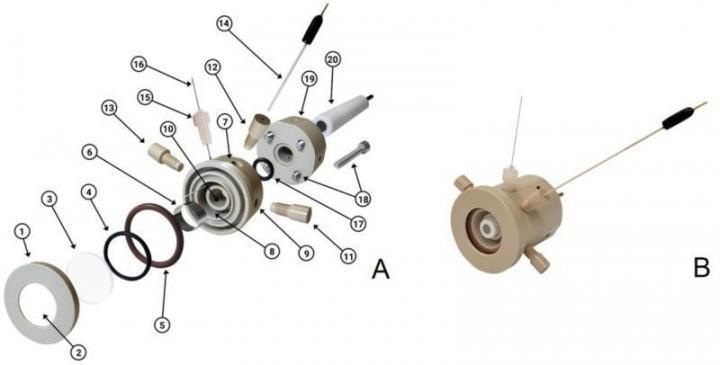Dec 22 2020
Scientists from the Center for Innovation in New Energies (CINE) together with researchers from the Brazilian Synchrotron Light Laboratory (LNLS), a unit of the Brazilian Center for Research in Energy and Materials (CNPEM), have created a new device that helps gain detailed insights into what happens during electrochemical reactions.
 Schematic of novel cell: (1) threaded lip; (2) aperture for passing radiation beam; (3) window; (4, 5, 17) O-ring; (6, 16) counterelectrode; (7) cell body part 1; (8) chamber for electrolyte, counterelectrode and reference electrode; (9, 11, 13) electrolyte inlet-outlet; (10) work electrode inlet; (12) reference electrode inlet; (14) reference electrode; (15) counterelectrode inlet; (18) bolt; (19) cell body part 2; (20) work electrode. Image Credit: Researcher’s archive.
Schematic of novel cell: (1) threaded lip; (2) aperture for passing radiation beam; (3) window; (4, 5, 17) O-ring; (6, 16) counterelectrode; (7) cell body part 1; (8) chamber for electrolyte, counterelectrode and reference electrode; (9, 11, 13) electrolyte inlet-outlet; (10) work electrode inlet; (12) reference electrode inlet; (14) reference electrode; (15) counterelectrode inlet; (18) bolt; (19) cell body part 2; (20) work electrode. Image Credit: Researcher’s archive.
CINE is an Engineering Research Center (ERC) launched by FAPESP (São Paulo Research Foundation) and Shell and is hosted by the University of Campinas (UNICAMP) in São Paulo, Brazil.
The spectroelectrochemical cell is a device that enhances the performance of batteries, electrolyzers, fuel cells and other appliances that transform chemical energy into electricity or vice versa.
There have been extensive studies on this type of equipment as part of the measures to develop renewable energy generating and storage solutions.
The latest device is a cell that can be applied to track electrochemical experiments that use a range of spectroscopic instruments running in particular frequency bands of the electromagnetic spectrum, like X-rays, visible light and infrared, to examine multilaterally the behavior of materials in electrochemical reactions and molecules present in both electrolyte solution and electrodes.
An article on the study has been published as a front cover feature by the journal ChemElectroChem, together with an interview with Pablo Sebastián Fernández, the last author of the study and a researcher at CINE.
The main difference and advantage of our device is that different kinds of analysis can be performed with a single cell, thanks to a window that can be swapped out in accordance with the analysis of interest. It’s possible to use windows transparent to infrared, windows transparent to visible light and windows transparent to X-rays, obtaining spectroscopic analysis in each of these frequency bands, among other things.
Pablo Sebastián Fernández, Researcher, Center for Innovation in New Energies
This implies that a single cell can be used for in situ infrared spectroscopy, Raman spectroscopy (which makes use of visible light) and X-ray absorption and diffraction, among other methods.
Apart from the unique window, the device includes all the usual components of an electrochemical cell, like counterelectrode, reference electrode, work electrode and electrolyte with salts and molecules of interest.
The electromagnetic radiation beams that pass through the window interact with both the molecules of interest, which are in the electrolyte, and the catalyst whose efficiency is being studied.
Pablo Sebastián Fernández, Researcher, Center for Innovation in New Energies
According to Fernández, one more benefit of the device is that the electrolytic solution can be altered at the time of the analysis and quantified under flow conditions, due to the architecture of the cell.
Journal Reference:
Bott-Neto, J. L., et al. (2020) Front Cover: Versatile Spectroelectrochemical Cell for In Situ Experiments: Development, Applications, and Electrochemical Behavior. ChemElectroChem. doi.org/10.1002/celc.202001242.